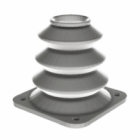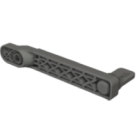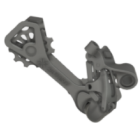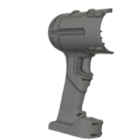Factors affecting print cost
The cost of 3D printing isn’t a fixed number — it’s the sum of many small decisions and variables. From material selection and print settings to machine choice and labor input, even a minor tweak can make a significant difference in the final price. Whether you’re quoting for a customer or optimizing your own production, understanding these factors affecting print cost helps you work smarter and reduce waste — without compromising quality.
Material type and usage
Material is often the most obvious cost driver, but its influence goes beyond just price per gram or milliliter. Some materials — like standard PLA — are inexpensive and easy to print. Others, such as high-performance nylons, composites, or resins, can cost 5 to 10 times more.
Key variables:
- price per unit (gram/ml/kg),
- density and required volume,
- waste or unused material (especially in SLS),
- support structure usage — excess supports = more waste.
The more complex the part, the more material waste you may generate — which increases overall material cost.
Print time and machine operating cost
Print time has a direct impact on cost — especially when calculated per hour. A larger, slower print ties up the printer for longer, increasing operating expenses.
Influencing factors include:
- layer height — thinner layers mean higher resolution but longer print times
- infill density — a solid part takes much longer to print than a hollow one
- print speed settings — conservative speeds may improve quality but raise time-based cost
- nozzle size — smaller nozzles extend print time, even if they enhance detail
Industrial machines typically have a higher hourly cost due to energy consumption, wear, and amortization — even when left unattended.
Post-processing time and labor
Finishing a print often takes just as long as printing it. Whether you’re removing supports, sanding, curing resin, or dyeing a powder print, every minute spent in post-processing translates to labor cost.
What increases this cost?
- Support complexity,
- part orientation (more overhangs = more cleanup),
- surface finish expectations — sanding and polishing take time,
- volume of parts — larger batches need more handling, cleaning, and sorting.
Even for personal projects, time spent post-processing is a resource worth factoring in — especially when scaling up production.
Printer type and technology
Different printing technologies come with different cost profiles. FDM may be cheap to operate, but slower and more labor-intensive. SLS and SLA offer higher precision and require less support material, but they come with their own overheads — like powder management or resin curing.
Cost-impacting traits by technology:
- FDM – low material cost, high post-processing time,
- SLA/DLP – medium material cost, requires cleaning and UV curing,
- SLS – efficient for batch printing but higher per-print energy use,
- DMLS/SLM (metal) – extremely expensive machines, high energy cost, complex post-processing.
Choosing the right process for the part can help optimize total cost — especially in professional environments.
Design complexity and geometry
Sometimes, it’s not the print settings or material that drive up the cost — it’s the part itself. Complex geometries require more supports, finer resolution, and more cautious orientation. Even if the part is small, its shape might demand significantly more machine time and finishing effort.
Cost-impacting design traits:
- thin walls or delicate features,
- high surface detail,
- nested assemblies or multi-component builds,
- organic or curved shapes that need support scaffolding.
Designing with printability in mind — or simplifying where possible — can lower both material and labor costs significantly.
Summary insight
No single factor determines print cost on its own. It’s the combination of material, time, technology, design, and labor that tells the full story. Understanding how each piece fits into the cost puzzle lets you make smarter decisions — whether you’re optimizing for affordability, scalability, or speed.
| Factor | Impact on cost | Why it matters |
|---|---|---|
| Material type | ★★★★☆ | High-performance materials are more expensive and may require more precise handling |
| Print time | ★★★★★ | Longer prints increase machine wear, electricity usage, and overall production time |
| Infill and resolution | ★★★★☆ | Higher infill or finer layers = more material + longer job |
| Support structures | ★★★☆☆ | More supports = more waste + more post-processing |
| Post-processing effort | ★★★★☆ | Labor-intensive finishing increases total unit cost |
| Printer type / tech | ★★★★★ | Some technologies are more energy- or equipment-intensive than others |
| Design complexity | ★★★☆☆ | Complex shapes may slow print speed and demand careful orientation |
Explore also
- How to calculate 3D printing cost?
- 3D printing: in-house vs outsourcing
- Is 3D printing cost-effective for production and prototyping?
- Is buying a 3D printer worth it in 2025?
- How much is 3D printing?
- Is 3D printing profitable?
- How to reduce 3D printing cost
- Do 3D printers use a lot of electricity?
Related categories













